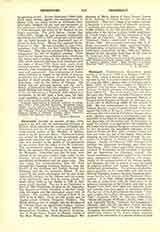

Chicoutimi, Diocese of, created, May 28, 1878, a part of the civil and the ecclesiastical Province of Quebec, which embraces the counties of Charlevoix, Chicoutimi, and Lac St.-Jean, and is situated in the northeastern section of the Province of Quebec, north of the St. Lawrence River. Charlevoix county was settled by the French in the seventeenth and eighteenth centuries, and Chicoutimi and Lac St.-Jean were founded in the middle of the nineteenth by the settlers from the valley of the St. Lawrence. This mountainous region contains the Saguenay River, the extensive lakes known as the St.-Jean and the Mistassini. Chicoutimi and Lac St.-Jean were centers of an extensive lumber trade earlier in the century; today they are better known for their agricultural development and the paper pulp. This vast region has communication with the West through the Canadian Northern Railway, with the interior of the continent and Europe through the Saguenay and the St. Lawrence Rivers. It was served by the Jesuit missionaries till the end of the eighteenth century; by the Oblates until the middle of the nineteenth; since then by secular priests. A small church built by the Jesuits in 1747 at Tadousac is still standing. The see is at Chicoutimi, a town of 7000 inhabitants, situated on the Saguenay. The diocesan seminary comprises a classical college with 200 pupils and the theological school with 28 students. The parishes have increased from 24 in 1878 to 55 in 1907. There are 105 secular and 18 regular priests (Oblates, Trappists, Eudists). The Marist Brothers have 6 colleges, and the Brothers of St. Francis Regis an agricultural Orphan Asylum. There are 340 sisters of the following institutes: Hospitalieres, Ursulines, Good Shepherd, Congregation of Notre Dame, Sisters of Charity, Sisters of the Holy Rosary, the Petites-Franciscaines Missionaires de Marie, Sisters of Good Council, Sisters of St. Anthony of Padua, Servants of the Blessed Sacrament. They have charge of an orphan asylum, 3 hospitals, 2 female schools of domestic economy, 7 convents, and many parochial schools. There are 15,000 children in the 310 parochial schools. The population of the diocese is about 66,000 inhabitants of French origin, who, with the exception of about fifty, are all Catholics. The first bishop was Msgr. Dominique Racine, consecrated August 4, 1878; d. January 28, 1888. His successors have been Msgr. L. N. Begin, consecrated October 28, 1888; appointed Coadjutor Archbishop of Quebec, December 22, 1891; Msgr. M. T. Labrecque, consecrated May 22, 1892, and Administrator of the Apostolic Prefecture of the Gulf of St. Lawrence from 1872 to 1903.
V. A. HUARD

